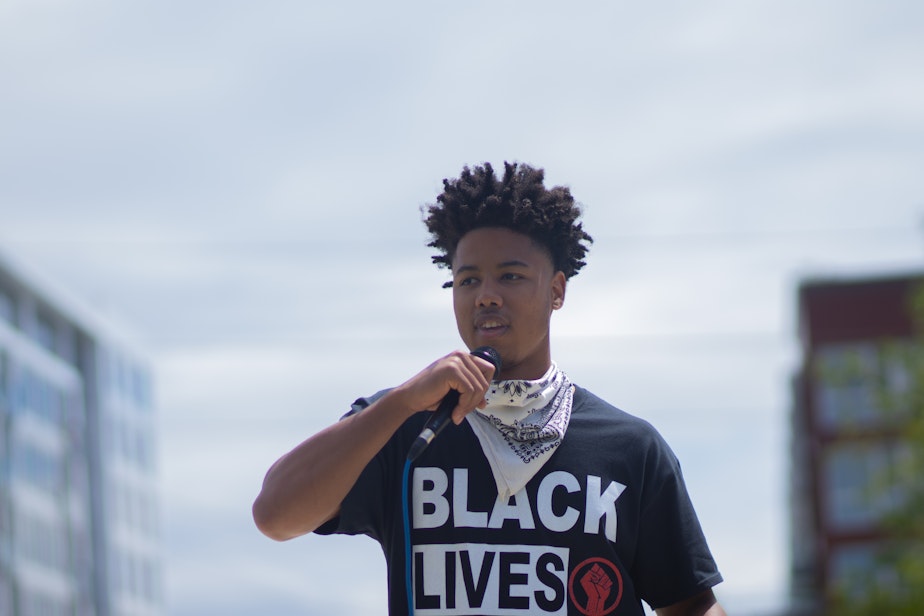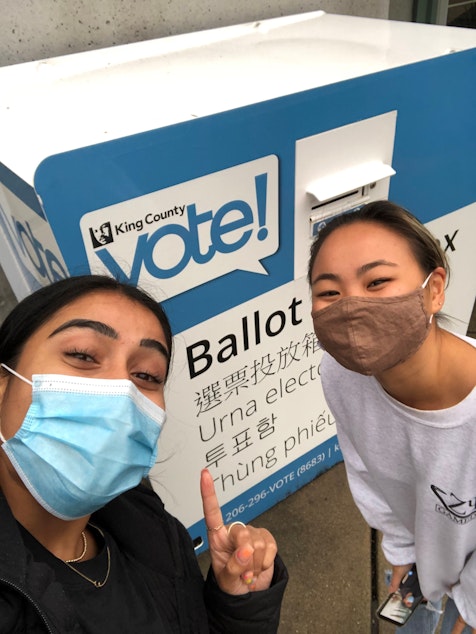They spent their summers at protests, now it's time to vote

This summer thousands of teens and young adults marched in the streets for racial justice. It came after three and half years of youth demonstrations: students walking out of school for the climate crisis; high schoolers demanding gun reform; and countless protests against President Donald Trump.
Now these same young people are organized for their next big move: voting in their first presidential election.
Capitol Hill this summer was, at times, chaotic.
Tear gas. Rubber bullets. And hundreds – sometimes thousands – of organized young people standing up to racism and police brutality.
Right in the middle of everything that was going on, beneath the umbrellas and clouds of pepper spray, were activists carrying clip boards. Clip boards they got from the nearby Washington Bus, a group that helps people register to vote.
Danny Villars, field director at Washington Bus, says he remembers people showing up during the height of the protests.
“Asking us like, 'Hey, is there more we can do? Is there a way we can take some of this energy towards the election this fall?’” Villars said.
Sponsored
He says he’s used to registering voters on school campuses or during online events. This was something new. This time people were coming to him.
The Washington Bus office is near where the protests were happening in Capitol Hill and Villars said people, “showed up at our office and got trained on how to register voters. They collected the materials and then went out day after day to go register other young people at these protests to vote.”

One of those people was not only protesting, but was also organizing his friends -- 19-year-old Trey Rudolph, an organizer with the Eastside Change Coalition. The Coalition held Black Lives Matter rallies and educational talks in Redmond, Kirkland, and Bellevue this summer.
Rudolph voted for the first time in October and says as he was filling out his ballot he thought of all of the civil rights activists who came before him.
Sponsored
“It was a moment of gratitude really,” he said. “I was just thinking back to the people before me who had really fought tooth and nail … blood, sweat, and tears so that I could have this privilege.”
Rudolph says part of starting the Coalition was not only to hold demonstrations but also to focus that energy on organizing young people of color to vote.
“We wanted to show the youth that this is our country. This is our future and if we work together and amass all the collective, youthful energy that we can, this is a country that we can have major impact on,” Rudolph said.
The Coalition is building on a lot of young momentum around the area. Before this year’s protests Seattle had already seen record-setting climate marches and students rallying for gun reform. Many people who marched in protest to the last presidential election are voting for the first time in this one.

Sponsored
Cymran Giri, 21, is a senior at Seattle University studying business management. She marched this summer with friends during Black Lives Matter demonstrations and voted for president for the first time this fall.
“I'm voting for Joe Biden and Kamala Harris because as a woman, as a brown girl,” Giri said. “I think that it's super important that I voted for a woman - a smart, powerful, brown, biracial woman because I think a lot of people tell their daughters, ‘Oh, you know, you can grow up to be president one day.’ If I have a daughter one day, I want to tell her I voted for a woman and you can become vice president and president. I think that is what was most important for me in this election, because you can't tell girls that they can be president if you're not willing to vote for one.”

Marina Rojas, 24, lives in Federal Way and supported Bernie Sanders during the Democratic primary. She says she felt a disillusioned by the process when Sanders dropped from the race. During the protests over the summer, however, Rojas says she connected to a larger cause to remove the president. Sanders stepping down was devastating, Rojas said, but by no means was it the end. “
"We are so powerful, we have been convinced for too long that we aren’t – but we have so much power,” Rojas said.
Sponsored
For her first presidential election she walked her ballot to a drop box with her dog. The next day she took her 21-year-old brother to vote for the first time, too.




